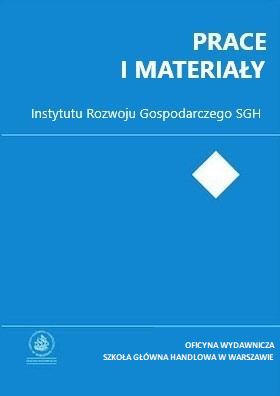Zastosowanie modeli czynnikowych do konstrukcji barometru koniunktury na podstawie badań ankietowych
##plugins.themes.bootstrap3.article.main##
Abstrakt
W opracowaniu przedstawiono syntetyczny wskaźnik aktywności gospodarczej w Polsce (barometr koniunktury), zbudowany na podstawie danych ankietowych Instytutu Rozwoju Gospodarczego SGH i Instytutu Transportu Samochodowego. Do oszacowania barometru koniunktury zastosowano podejście wykorzystujące modele czynnikowe, w tym dynamiczne. Estymacje przeprowadzono trzema alternatywnymi metodami. Oszacowany na ich podstawie nieobserwowalny czynnik potraktowano jako syntetyczny wskaźnik aktywności gospodarczej. Dla odniesienia analizą objęto również barometr koniunktury IRG SGH, konstruowany wg podejścia tradycyjnego. W świetle przeprowadzonych badań zastosowanie modeli czynnikowych do estymacji wskaźnika aktywności gospodarczej opartego na danych ankietowych nieznacznie poprawia użyteczność tego typu wskaźników w monitorowaniu wahań zmiennej referencyjnej (PKB). Prezentowane podejście wymaga dalszych analiz, które pomogą poprawić jakość diagnostyczną barometru koniunktury. (abstrakt oryginalny)
##plugins.themes.bootstrap3.article.details##
Bibliografia
Bai J., Ng S., Determining the number of factors in approximate factor models, „Econometrica”, vol. 70, nr 1, 2002, s. 191-221
Bry G., Boschan C., Cyclical analysis of time series: Selected procedures and computer programs, National Bureau of Economic Research, Nowy Jork 1971
Doz C., Giannone D., Reichlin L., A two-step estimator for large approximate dynamic factor models based on Kalman filtering, „Journal of Econometrics”, vol. 164, nr 1, 2011, s. 188-205
Forni M., Altissimo F., Cristadoro R., Lippi M., Veronese G., New Eurocoin: Tracking economic growth in real time, Technical report, University of Modena and Reggio Emilia, 2008
Forni M., Hallin M., Lippi M., Reichlin L., The generalized dynamic factor model: Identification and estimation, Technical report, C.E.P.R. Discussion Papers, 1999
Forni M., Hallin M., Lippi M., Reichlin L., The generalized dynamic factor model: One-sided estimation and forecasting, CEPR Discussion Papers, nr 3432, 2002
Gayer C., Genet J., Using factor models to construct composite indicators from BCS data. A comparison with European Commission confidence indicators, European Economy - Economic Papers, nr 240, KE, Bruksela 2006
Hallin M., Liska R., Determining the number of factors in the general dynamic factor model, „Journal of the American Statistical Association”, vol. 102, 2007, s. 603-617
Klimkowska J., Koniunktura w gospodarce polskiej w I półroczu 2004 r., „Zeszyty Koniunktury Gospodarki Polskiej”, nr 20, 2004
Komisja Europejska, Business climate indicator for the Euro Area, Bruksela 2000
Komisja Europejska, The joint harmonised EU programme of business and consumer surveys. User guide, Technical report, ECFIN, Bruksela 2007
Talaga L., Zieliński Z., Analiza spektralna w modelowaniu ekonometrycznym. PWN, Warszawa 1986
Marcellino M., Dynamic factor models for survey-based confidence indicators, 2006
Matkowski Z., (1999). Barometry koniunktury dla gospodarki Polski. „Prace i Materiały Instytutu Rozwoju Gospodarczego, 64, SGH, Warszawa
Matkowski Z., Badania gospodarki polskiej, stan bieżący i perspektywy rozwoju, „Prace i Materiały Instytutu Rozwoju Gospodarczego SGH”, nr 72, SGH, Warszawa 2002 (a)
Matkowski Z., Wskaźniki klimatu gospodarczego jako narzedzie oceny stanu gospodarki, „Ekonomista”, 1, 2002 (b)
Matkowski Z., Composite indicators of business activity for macroeconomic analysis, „Prace i Materiały Instytutu Rozwoju Gospodarczego SGH”, nr 74, SGH, Warszawa 2004
Priestley M. B., Spectral analysis and time series, Academic Press, 1989
Skrzypczyński P., Metody spektralne w analizie cyklu koniunkturalnego gospodarki polskiej, „Materiały i Studia NBP”, 252, Warszawa 2010
Stanek K., Koncepcja barometru gospodarczego koniunktury. Badania koniunktury gospodarki Polski, SGH, Warszawa 1993
Stanek K., Wybrane metody badania kondycji polskiej gospodarki za pomocą syntetycznych wskazników koniunktury gospodarczej, „Prace i Materiały Instytutu Rozwoju Gospodarczego SGH”, nr 65, SGH, Warszawa 1999
Stock J. H., Watson M. W., Forecasting using principal components from a large number of predictors, „Journal of the American Statistical Association”, vol. 97, 2002, s. 1167-1179
Stock J. H., Watson M. W., Dynamic factor models, w: Oxford handbook of economic forecasting, pr. zb. pod red. M. P. Clementsa i D. F. Hendry’ego, Oxford University Press, 2010
Strigel W., Die Konjunkturumfragen des Ifo Institut für Wirtschaftsforschung, „Allgemeines Statistisches Archiv”, nr 2, 1965
